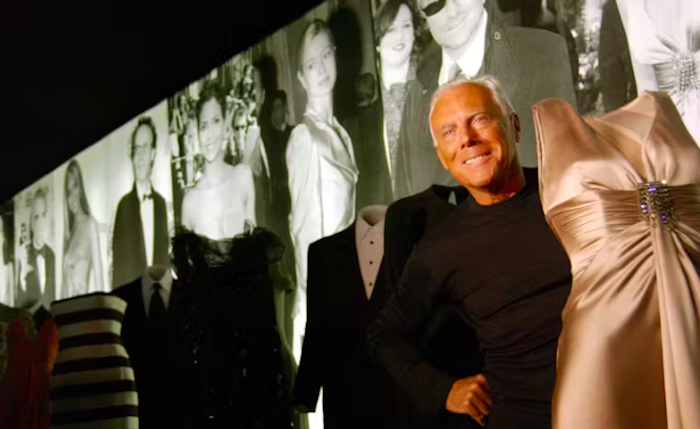
Armani'S Hollywood Hustle: How A Fashion Icon Dressed Tinseltown To Win The Masses on ONDA LA

From Milan to Malibu: Armani’s Rise to Fame
With the passing of Giorgio Armani, the fashion world mourns a true titan whose influence stretched from the cobblestone streets of Italy to the glitzy boulevards of Hollywood. Born in Piacenza in 1934, Armani ditched med school dreams in 1954 for a gig at Milan’s La Rinascente department store, where he got his first taste of fabrics and the magic of fashion licensing. It was there, surrounded by bolts of cloth and bustling shoppers, that he learned how to make luxury accessible to the everyday Joe and Jane.
This SoCal-vibin’ idea of affordable glam became his ticket to stardom. Inspired by Pierre Cardin’s licensed lines at lower price points, Armani saw the potential in diversifying a brand to hook different crowds - a strategy that would later fuel his global takeover. By 1975, teaming up with architect Sergio Galeotti, he launched his own label, ditching stiff suits for relaxed, effortlessly cool tailoring that screamed understated chic.
Just three years later, in 1978, he inked a game-changing deal with Gruppo Finanziario Tessile to churn out luxury ready-to-wear under his eagle eye. That move birthed the Giorgio Armani Corporation, with multiple lines aimed at international markets, setting the stage for his Hollywood invasion. Talk about a glow-up with West Coast potential!
Cracking the American Market with Casual Cool
Armani’s first ready-to-wear drop hit the U.S. in 1979, and let’s just say he tailored his game plan to fit American tastes like a bespoke suit. He tapped Edward Glantz, a former Barney’s New York insider, to tweak his designs for Stateside shoppers who craved low-maintenance, wallet-friendly threads. Glantz kept that signature relaxed elegance alive with permanent-press fabrics - way less ironing drama - and cheaper materials to slash costs without skimping on style.
While Milan shoppers shelled out $600 for a jacket and $800 for a suit, Armani’s U.S. sports and formal-wear lines ranged from $150 to $450, popping up at fancy spots like Bergdorf Goodman and Nan Dusking. It was luxe you didn’t need a Beverly Hills postcode to afford, and Americans ate it up faster than avocado toast at a brunch spot on Melrose.
“Armani didn’t just sell clothes - he sold a lifestyle that felt within reach, whether you were in LA or Middle America,” says a fashion historian reflecting on his impact.
Hollywood Hook-Up: ‘American Gigolo’ and Beyond
Armani’s big Stateside break came in 1980 with the steamy flick American Gigolo, where Richard Gere’s high-rolling escort, Julian Kay, rocked lightweight Armani suits that could flip from boardroom to beach casual with a tie swap or a polo pairing. Using softer, womenswear-inspired fabrics, these looks were pure laid-back LA energy, and they hit American audiences like a Santa Monica sunset - unforgettable.
The film’s wardrobe, pulled from Armani Collezioni - his more affordable white label for U.S. buyers - meant fans could cop similar pieces straight off the rack. As fashion scholar John Potvin pointed out, the movie didn’t just launch Armani stateside; it cemented Gere as a heartthrob. Add in the ‘80s power-dressing craze with those broad-shouldered suits, and by 1982, Armani was only the second designer ever to grace the cover of Time magazine. Talk about flexing!
Hollywood became his playground, with over 200 films sporting his threads over the years. From The Untouchables in 1987 to The Wolf of Wall Street in 2013, Armani suits dressed hard-charging characters, solidifying his rep as the go-to for power and style - even if 70% of those suits were machine-made with some production in Hong Kong. It was all about the illusion, baby.
Rodeo Drive Royalty: Armani’s Red Carpet Reign
Armani knew celebrity clout was the ultimate currency in Tinseltown, so in 1988, he brought on Wanda McDaniel as his West Coast liaison to style Hollywood’s elite for both on-screen swagger and off-screen paparazzi snaps. A former journo turned Hollywood insider, McDaniel took inspo from Fred Hayman’s VIP pampering at his unrelated Giorgio Beverly Hills boutique on Rodeo Drive (a luxe shopping strip in Beverly Hills for the uninitiated), and applied that star treatment to Armani’s new flagship store, which opened that August to cater to A-listers and the “working rich,” per the LA Times.
McDaniel later became president of the Rodeo Drive Committee, a group shaping the iconic district’s vibe, originally founded by Hayman, who also coordinated Oscars fashion. Under her watch, Armani became a red carpet staple, with media buzzing over his gowns and even unisex suits at awards shows. Armani himself noted that Oscar dresses were always the first to sell out - proof that Hollywood dreams translate to cold, hard cash.
Star Power as a Business Blueprint
Armani’s obsession with entertainment promo only grew, leading to the creation of an Entertainment Industry Relations department - still kicking today - to manage celebrity ties and styling across his lines. This move basically wrote the playbook for other fashion houses to build their own VIP squads, proving that star power isn’t just glitz; it’s a goldmine.
Reflecting on his red carpet legacy, Armani once summed it up as a mix of “prestige and dreams” that ultimately led to dollars and cents. From Milan to Malibu, he didn’t just dress the elite - he made every dreamer feel like they could step into a Hollywood moment, one affordable suit or gown at a time. That’s the kind of Cali cool legacy that never goes out of style.






